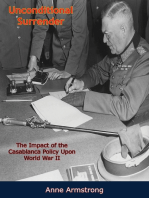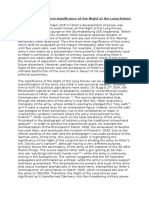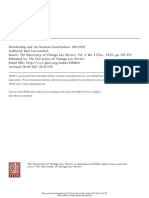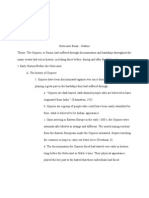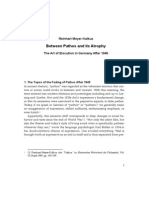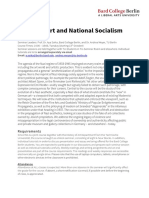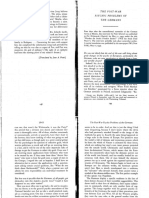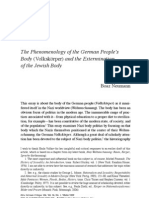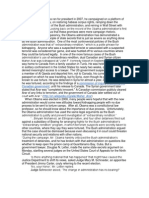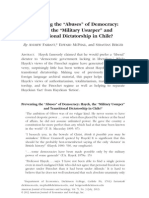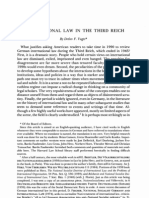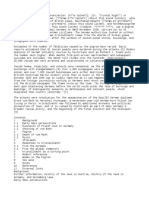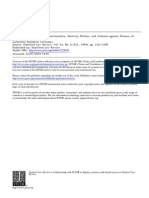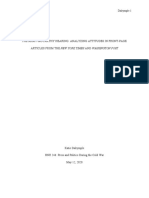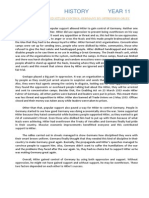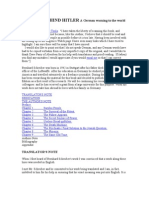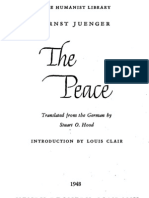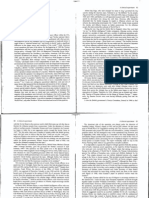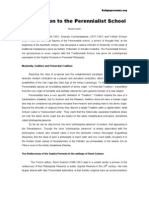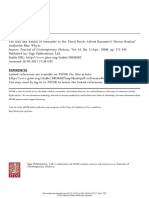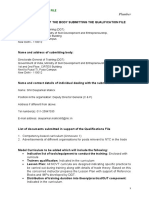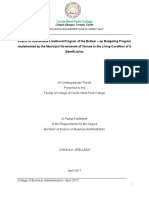Professional Documents
Culture Documents
Hitler in A Social Context
Uploaded by
viktor369Original Description:
Original Title
Copyright
Available Formats
Share this document
Did you find this document useful?
Is this content inappropriate?
Report this DocumentCopyright:
Available Formats
Hitler in A Social Context
Uploaded by
viktor369Copyright:
Available Formats
Conference Group for Central European History of the American Historical Association
Hitler in a Social Context
Author(s): Michael H. Kater
Source: Central European History, Vol. 14, No. 3 (Sep., 1981), pp. 243-272
Published by: Cambridge University Press on behalf of Conference Group for Central
European History of the American Historical Association
Stable URL: http://www.jstor.org/stable/4545932
Accessed: 10-12-2016 12:42 UTC
REFERENCES
Linked references are available on JSTOR for this article:
http://www.jstor.org/stable/4545932?seq=1&cid=pdf-reference#references_tab_contents
You may need to log in to JSTOR to access the linked references.
JSTOR is a not-for-profit service that helps scholars, researchers, and students discover, use, and build upon a wide range of content in a trusted
digital archive. We use information technology and tools to increase productivity and facilitate new forms of scholarship. For more information about
JSTOR, please contact support@jstor.org.
Your use of the JSTOR archive indicates your acceptance of the Terms & Conditions of Use, available at
http://about.jstor.org/terms
Cambridge University Press, Conference Group for Central European History of the
American Historical Association are collaborating with JSTOR to digitize, preserve and extend access to
Central European History
This content downloaded from 161.53.243.70 on Sat, 10 Dec 2016 12:42:30 UTC
All use subject to http://about.jstor.org/terms
Hitler in a Social Context
MICHAEL H. KATER
continued to grow. Publications centering on the Fiihrer of the
IN
recent
biographical
literature about Adolf Hitler has
Nazi party
are nowyears
so numerousthe
that not
long ago, one reputable
British historian felt compelled to apologize for introducing yet "an?
other book about Hitler."1 But with all this activity, most scholars
agree that few if any of the new studies on Hitler have significantly
extended our understanding of the German dictator beyond that pro?
vided by Lord Alan Bullock's authoritative biography, first published
in 1952 and now a classic. Novel and trendy approaches to the subject,
such as those ofthe "psychohistorians," have not broken new ground.
Gerhard L. Weinberg's balanced judgment of Robert G. L. Waite's psychobiography of Hitler is that "the very great strengths ofthe book are
precisely in the more traditional portions, and the weaknesses in the
least traditional."2 The more current life histories?such as Joachim
Fest's, which was clearly designed to supersede Bullock's work as well
as to be a huge commercial success?remain of questionable value either
because they restrict themselves to known factual information as their
basis of documentation or because they lack truly original insights. Sym-
posia, some of them too obviously media-conscious, have compounded
the difficulty of understanding Hitler because they have asked irrelevant
questions or have simply restated well-worn theses. As an inevitable
consequence of the publicity surrounding Hitler studies today, falsehoods have been perpetrated by such writers as Robert Payne, who
I am indebted to the Guggenheim Foundation (New York) and the Killam Program
of the Canada Council (Ottawa) for having financed the research for this article.
1. William Carr, Hitler: A Study in Personality and Politics (New York, 1979), p. vii.
2. Alan Bullock, Hitler: A Study in Tyranny (Harmondsworth, Penguin Books, 1969).
Weinberg's review is in The American Historical Review 83 (1978): 753-56. See Robert
G. L. Waite, The Psychopathic God: Adolf Hitler (New York, 1977). William S. Allen's
stern review iafournal of Modern History 50 (1978): 383-85, of Rudolf Binion, Hitler
among the Germans (New York, 1976), culminates in the book's characterization as "a
nearly perfect horrible example to train students about the misapplication of historical
data, to show them what can happen when a historian lets his thesis dominate the facts."
243
This content downloaded from 161.53.243.70 on Sat, 10 Dec 2016 12:42:30 UTC
All use subject to http://about.jstor.org/terms
244 Hitler in a Social Context
repeated a previously fabricated legend about an early sojourn of Hit?
ler's in England, and David Irving, who in so many words absolved the
Fuhrer of his guilt in the anti-Jewish holocaust.3
Although it is difficult to rank the existing treatises on Hitler on a
3. See Robert Payne, The Life and Death of Adolf Hitler (New York and Washington,
1973), PP- 93-102; David Irving, Hitler*s War (New York, 1977). Werner Maser's book,
Hitler (London, 1973) is a pretentious but unsuccessful attempt to upstage Bullock. Ma?
ser's latest book, Adolf Hitler: Das Ende der Fiihrer-Legende (Diisseldorf and Vienna, 1980),
constitutes a repetition of earlier views. For the scholar, it is just as useless as another
"new" biography, Norman Stone's speciously argued and undocumented book, Hitler
(London, 1980). As a conventional biography, Joachim C. Fest's study, Hitler (New
York, 1974), is much more impressive, yet because of its synthetic approach it lacks true
originality and contains hardly any archival references. John Toland's voluminous Adolf
Hitler (New York, 1976), like Maser's earlier biography, presents new facts but scarcely
any insights. Sebastian Haffiier's quite thoughtful study, Anmerkungen zu Hitler, 17th ed.
(Munich, 1978), nevertheless epitomizes the current West German trend to cash in on
the "Hider Wave" by presenting catchy themes with great fanfare after no original
research. For critiques of some ofthe above-mentioned titles see: Eberhard Jackel, "Literaturbericht: Riickblick auf die sogenannte Hider-Welle," Geschichte in Wissenschaft und
Unterricht 28 (1977): 695-710; Jackel, "Hider und der Mord an den europaischen Juden:
Die Widerlegung einer absurden These," Frankfurter Allgemeine Zeitung, Aug. 25, 1977;
Charles W. Sydnor, Jr., "The Selling of Adolf Hider: David Irving's HitWs War,"
Central European History 12 (1979): 169-99; Martin Broszat, "Hitler und die Genesis der
'Endlosung': Aus Anlass der Thesen von David Irving," Vierteljahrsheftefur Zeitgeschichte
2 5 (!977)* 739-7'5- Also see: Hermann Graml, "Probleme einer Hitler-Biographie: Kri-
tische Bemerkungen zu Joachim C. Fest," ibid. 22 (1974): 76-92; Henryk Olszewski,
"The Historical Greatness of Hitler and his Nazi Revolution (Critical reflections on Joa?
chim C. Fest's Book)," Polish Western Affairs 15 (1974): 117-35; Hellmuth Auerbach,
"Hitlers politische Lehrjahre und die Miinchener Gesellschaft 1919-1923," Vierteljahrs?
heftefur Zeitgeschichte 25 (1977): 2, n. 3. Also see the review of Maser's last book as well
as of Stone's biography by Andreas Hillgruber in Historische Zeitschrift 234 (1982): 48486. The following are examples of recent symposia organized to clarify the issues sur?
rounding Hider: Interdisciplinary Symposium Heidelberg, Spring 1975 (see Rhein-NeckarZeitung, Heidelberg, Apr. 8,1975); and English-German conference about "Herrschaftsstruktur und Gesellschaft des Dritten Reiches," hosted by the German Historical Insti?
tute London in Cumberland Lodge, Windsor Great Park, from May 9 through 11,1979
(see Frankfurter Allgemeine Zeitung, May 25, 1979; Klaus Hildebrand, "Nationalsozia?
lismus ohne Hider? Das Dritte Reich als Forschungsgegenstand der Geschichtswissenschaft," Geschichte in Wissenschaft und Unterricht 31 [1980]: 289-304. Most ofthe con?
ference papers have been published in: Gerhard Hirschfeld and Lothar Kettenacker, eds.,
Der "Fuhrerstaat": Mythos und Realitdt: Studien zur Struktur und Politik des Dritten Reiches
[Stuttgart, 1981]. See the author's review of this book in Journal of Modern History, forthcoming in 1983. Regarding a conference held at the Institut fiir Zeitgeschichte in Munich,
see Totalitarismus und Faschismus: Eine wissenschaftliche und politische Begriffskontroverse:
Kolloquium im Institut fiir Zeitgeschichte am 24. November 1978 (Munich and Vienna, 1980).
See the author's general criticism in "Die Sozialgeschichte und das Dritte Reich: Oberlegungen zu neuen Biichern," Archiv fiir Sozialgeschichte 22 (1982).
This content downloaded from 161.53.243.70 on Sat, 10 Dec 2016 12:42:30 UTC
All use subject to http://about.jstor.org/terms
Michael H. Kater 245
scale of values, it is clear that even the best of them, inc
standard volume, have somehow failed to classify Hitler
a sociological or sociohistorical perspective. William S. Al
criticism of John Toland's study?that it presents a ' 'H
Nazism"?applies to a whole slew of writings whose
lacked the methodological devices needed to define the p
the Fiihrer's personality either with any degree of scientific
through any reference to his immediate or general envi
land obviously disregarded social history in his dispassion
treatment of Hitler. The early biographers, such as Ott
Lutz Graf Schwerin von Krosigk, were personally close
therefore lacked the more objective categories of definit
resorted to demonological jargon in an effort to characterize
Even Bullock, though his view of Hitler was less shroud
istic pretensions, tended to see the Fuhrer as a singular forc
a sort of trailblazer of fate whose social environment w
insignificant.6
Then, in the mid-sixties, individual scholars began to
academic community ofthe need for an examination of
ditions that had elevated and sustained Hitler, an examin
to refine the techniques of analysis in social-scientific t
born, Theodor Schieder, Albrecht Tyrell, and Peter Stern
those voices?the last not an historian, but a student of G
ture. In the late sixties, at a time when experiments in socia
slowly coming to the notice of scholars in the neighbori
of the humanities, the American Joseph Nyomarkay was
torian to publish a pioneering study of Hitler during his
analyzing the Fuhrer phenomenon in terms of Max We
4. See William S. Allen, "Hitler De-Luciferized," The Nation, Janua
similarly critical note see Martin Broszat, "Soziale Motivation und Fu
Nationalsozialismus," Vierteljahrsheftefiir Zeitgeschkhte 18 (1970): 399.
24, is more ambivalent.
5. See Otto Strasser, Hitler und Ich (Buenos Aires, 1940), p. 70; Lutz Gra
Krosigk, Es geschah in Deutschland: Menschenbilder unseres fahrhunde
Stuttgart, 1951), pp. 220, 222. Also see Fritz Wiedemann, Der Mann de
wollte: Erlebnisse und Erfahrungen des Vorgesetzten Hitlers im 1. Weltkrieg
personlichen Adjutanten (Velbert and Kettwig, 1964), p. 82; Otto Diet
Knew (London, 1957), pp. 5, 10.
6. The quintessence of Bullock's view is presented on pp. 803-6 ofthe
This content downloaded from 161.53.243.70 on Sat, 10 Dec 2016 12:42:30 UTC
All use subject to http://about.jstor.org/terms
246 Hitler in a Social Context
matic model.7 Yet in spite of these advances Joachim Fest in his muchpublicized biography of Hitler still emulated older interpretations when
in the early seventies he spoke vaguely of Hitler as a "point of conver?
gence for so many nostalgias, anxieties, and resentments," thus allegorizing the Fuhrer in pseudosociohistoric language as a "historical figure."
And the renowned Bonn University historian Karl Dietrich Bracher
merely echoed such phraseology when he wrote in 1976 that Hitler had
"represented the essential tendencies of his time."8 Since that time,
Fest's (if not Bracher's) insensitivity to the approach ofthe more socially
oriented historians has been taken to task by West German scholars
such as Hermann Graml and Hellmuth Auerbach who, though rejecting
the crude East German claim that Hitler was solely a product of "monopoly capitalism," have nevertheless insisted that in critical retrospect
he cannot be "abstracted" from his social surroundings.9 The purpose
ofthe present essay is to further the understanding of Hitler's personality
and preeminence by analyzing the social conditions that surrounded
his adolescence and supported his rise to and stay in power.
On the basis of reliable historical research, one may reasonably assume
that Hitler began his conscious existence as a sociopolitical animal folj. Hajo Holborn, "Origins and Political Character of Nazi Ideology," Political Science
Quarterly 79 (1964): 554; Theodor Schieder, Hermann Rauschnings llGesprache mit Hitler"
als Geschichtsquelle (Opladen, 1972), PP- 54~55; Albrecht Tyrell, Vom "Trommler" zum
"Fiihrer": Der Wandel von Hitlers Selbstverstdndnis zwischen 1919 und 1924 und die Entwkk?
lung der NSDAP (Munich, 1975), P- 9; J. P- Stern, Hitler: The Fiihrer and the People (Glasgow, 1975)> P-15; Joseph Nyomarkay, Charisma and Factionalism in the Nazi Party (Minneapolis, 1967). See also the two books by Dietrich Orlow, The History ofthe Nazi Party:
1919-1933 (Pittsburgh, 1969); and The History ofthe Nazi Party: 1933-1945 (Pittsburgh,
1973)- It has to be emphasized, however, that from a social-scientific perspective, the
German-American sociologist Hans Gerth was the first scholar, in 1940, to analyze Hit?
ler's charisma. See his article, "The Nazi Party: Its Leadership and Composition," Ameri?
can Journal of Sociology 45 (1940): 517-41.
8. Fest, p. 7; Karl Dietrich Bracher, "The Role of Hider: Perspectives of Interpreta?
tion," in Walter Laqueur, ed., Fascism: A Reader's Guide: Analyses, Interpretations, Bibliog?
raphy (Berkeley and Los Angeles, 1976), p. 221.
9. Auerbach, p. 1, n. 1; Graml. A noteworthy attempt in this direction has recently
been made in Britain by Ian Kershaw, "The Fiihrer Image and Political Integration: The
Popular Conception of Hitler in Bavaria during the Third Reich," in Hirschfeld and
Kettenacker, pp. 133-61. For a prototypical East German view of Hitler see Manfred
Weissbecker, "Zur Herausbildung des Fiihrerkults in der NSDAP," in Monopole und
Staat in Deutschland 1917-1945 (Berlin [East], 1966), pp. 119-21.
This content downloaded from 161.53.243.70 on Sat, 10 Dec 2016 12:42:30 UTC
All use subject to http://about.jstor.org/terms
Michael H. Kater 247
lowing his first public appearance in Munich in the f
is not easy to pinpoint his position in the social struct
or, for that matter, during the subsequent phases of
Contemporaries who observed him at close range, how
whelmingly united in reporting what they thought
butes ofa lower-middle-class personality and life-style. Ac
Hermann Rauschning and Albert Speer, Hitler's perso
flected, for instance, by the decorations and appointm
vate residences on the Obersalzberg or in Munich's Pri
?were pronouncedly petit bourgeois. Especially in his
struggle the leader of the Nazi party impressed thos
came from a posh upper-class background, such as Er
by his "provincial manner"?he was "like a waiter in a
restaurant"?and by "the petty bourgeois complex of
man of some attainment with a title of some sort." G
the Freikorps leader and friend of Ernst Rohm, foun
quious and insecure, yet at the same time often abra
ease in a social situation was noted by Otto Strasser's a
Blank, who was surprised to see Hitler tripping awkwa
carpet. Albert Speer, too, has referred to Hitler's "pr
ity," which betrayed his lack of formal education and led
literary clumsiness that was evident in the first draft
Throughout his life the Fuhrer was short on orthography
pseudoemotional concepts like Herzenshildung (educat
exhibited the petit bourgeois's typical propensity for
theories of hearsay, such as the one regarding fields o
the powers of "world ice" ("glacial cosmogony"); and
provincial's suspicion and fear of foreign countries an
As late as October 1914 he claimed to have encountered "th
men ever of my life"?French elite troops at the weste
the Third Reich he grew increasingly fond of cheap fe
finally, to round off this brief sketch of a German Kl
could never rid himself of certain angularities in his ev
with very close friends. This had applied in his early yout
ship with August Kubizek, and in his maturity it appli
io. See does. 63-67 in Eberhard Jackel, ed., Hitler: Sdmtliche Aufzeic
(Stuttgart, 1980; hereafter cited as Hitler: Aufzeichnungen), pp. 91-95
pp. 10-11; Erich Czech-Jochberg, Wie Adolf Hitler der Fiihrer wurde:
sation und Ziele der nationalsozialistischen Bewegung, 3rd ed. (Leipz
This content downloaded from 161.53.243.70 on Sat, 10 Dec 2016 12:42:30 UTC
All use subject to http://about.jstor.org/terms
248 Hitler in a Social Context
his liaison with Eva Braun, whom he often treated like a cheap mistress,
as on those occasions when he selected offensively gaudy costume jew-
elry for her. And, as Hugh Trevor-Roper (now Lord Dacre) noted
incisively, when Hitler hurried into a civil marriage ceremony with Eva
less than two days before their impending suicide, he gave the impression of someone who wished to put his affairs in order, in deference to
the existing conventions of society. Indeed, in those last hours of his
life, he associated himself, in the words of his personal testament, with
the "petty-bourgeois" background of Eva's relatives and, upon closer
reading, of his own.11
One may assume that Hitler, after having become a politically conscious agitator, up to his death never quite knew how to classify himself
in terms of accepted social criteria. In his postwar Munich years from
1919 to 1924 Hitler, in a confusing sequence, described himself at dif?
ferent points in time as a "merchant," a "worker," a "writer," a "selfemployed architectural draftsman," and as an "ordinary soldier."12 What
he did know, and could no more conceal from the readers otMein Kampf
than he could, after 1933, from his coterie in the after-dinner round,
was that his ancestors stemmed from the lumpenproletariat of Austrian
11. From the top, quotations are from: Ernst Hanfstaengl, Unheard Witness (Phila?
delphia and New York, 1957), pp. 34, 37,131 (also see pp. 194,234); Gerhard Rossbach,
Mein Weg durch die Zeit: Erinnerungen und Bekenntnisse (Weilburg/Lahn, 1950), p. 215;
entry for Feb. 15,1948, in Albert Speer, Spandau: The Secret Diaries (New York, 1976),
p. 92 (also see pp. 90-91,131); doc. 24 (Oct. 20, 1914) in Hitler: Aufzeichnungen, p. 59;
Hugh R. Trevor-Roper, The Last Days of Hitler (London, 1952), p. 183. Also see ibid.,
pp. 98-99, 182; Weigand von Miltenberg [Herbert Blank], Adolf Hitler Wilhelm III.
(Berlin, 1932), p. 19; Hermann Rauschning, Gesprdche mit Hitler (Zurich, 1940), pp.
18-19; entry for Nov. 5,1941, in Adolf Hitler: Monologe im Fuhrerhauptquartier 1941-1944:
Die Aufzeichnungen Heinrich Heims, ed. Wemer Jochmann (Hamburg, 1980) (hereafter
cited as Hitler: Monologe), p. 130; Wiedemann, pp. 78, 210-15; Dietrich, p. 153; Albert
Speer, Inside the Third Reich (New York, 1970), pp. 46, 58, 93; Hitler aus nachster Ndhe:
Aufzeichnungen eines Vertrauten 1929-1932, ed. Henry Ashby Turner, Jr. (Frankfurt a.M.,
1978; cited hereafter as Hitler aus nachster Ndhe), pp. 101-2; Strasser, p. 59; Alfred Rosen?
berg, Letzte Aufzeichnungen: Ideale und Idole der nationalsozialistischen Revolution (Got?
tingen, 1955), PP- 331-33; Max Weinreich, Hitler's Professors: The Part of Scholarship in
Germany's Crimes against the Jewish People (New York, 1946), p. 20; Michael H. Kater,
Das "Ahnenerbe" der SS 1935 bis 1945: Ein Beitrag zur Kulturpolitik des Dritten Reiches
(Stuttgart, 1974), P- 5i; Jochen von Lang, Der Sekretar: Martin Bormann: Der Mann, der
Hitler beherrschte (Stuttgart, 1977), p. 108; Haffiier, pp. 32-33; August Kubizek, The
Young Hitler I Knew (Westport, Conn., 1976), esp. pp. 217-18; Lothar Kettenacker,
"Sozialpsychologische Aspekte der Fuhrer-Herrschaft," in Hirschfeld and Kettenacker,
pp. 122-23.
12. Does. 64 (Oct. 19, 1919), 124 Quly 27, 1920), 458 (Jan. 13, 1923), 605 (Feb. 26,
1924) in Hitler: Aufzeichnungen, pp. 91, 165, 789, 1062, 1064.
This content downloaded from 161.53.243.70 on Sat, 10 Dec 2016 12:42:30 UTC
All use subject to http://about.jstor.org/terms
Michael H. Kater 249
society, that his own father Alois Hitler (alias Schick
illegitimate birth Hitler never acknowledged) had risen fr
depths to a comfortable lower-middle-class position, a
self had been destined by his parents to rise even fu
become a student." World history might have been d
done so; but he turned his back on institutionalized ed
sequently arrested his own social advancement, at leas
he knew?and critics have not failed to take notice?th
father had been upwardly mobile, he himself had tak
downward mobility, starting in those unsettled year
continuing until he joined the Bavarian regiment in M
There was never any reason for Hitler to identify himse
the upper bourgeoisie or the aristocracy. In fact, he vehem
any outside attempts to east him in the role of a bour
did he count himself among the lower middle class. (Th
that he did not occasionally display a tendency to upg
his relations. In a letter to a "dear doctor" dated Nov
he claims to have descended "from a somewhat mo
minded family." In Mein Kampf he speaks of himself
struction officer" [Bildungsoffizier] ofthe German army,
his designation was "contact person" [V-Mann]. He on
father as a "justice" fyustizrat], thus elevating Schickl
social elite.) It was the working class that seems to h
greatest sympathy; during the course of his life he oc
to it as the class dearest to his heart. Was that, perhaps, i
fact that as a common soldier in the trenches Hitler h
motion to the rank of noncommissioned officer becau
put him in the category of a petit bourgeois? Would it
in Mein Kampf he speaks consistently and extensively o
as a "worker" before his stint in the army? And why i
party propagandists to compare him to Lenin who
have climbed from similarly lowly origins (which wa
true)? And finally, would it explain why, in the summ
13. Adolf Hitler, Mein Kampf, ed. John Chamberlain et al. (New Y
9-14; Rauschning, pp. 161-62. Also see Konrad Heiden, A History o
(London, 1971; first published 1934), P? 54*, Fest, P- 37' Stern, p
"Die Krise des nationalsozialistischen Regimes am Vorabend des
und die forcierte Aufriistung: Eine Kritik," Vierteljahrsheftefur Zeit
380; Haffiier, p. 7.
This content downloaded from 161.53.243.70 on Sat, 10 Dec 2016 12:42:30 UTC
All use subject to http://about.jstor.org/terms
250 Hitler in a Social Context
referring to the Catholic Church, Hitler proudly remarked to his entourage that "the only other institution in which a man from the low?
est classes has the chance to rise so high" was "among us, in the Move?
ment"?14
Still, none of the conventional societal molds fitted Hitler properly,
and this suggests that at some point in his life he intentionally sought to
escape sociological classification. Not a worker, not a petit bourgeois,
certainly not a member of the social elites, Hitler preferred the label
"bohemian" or "artist," which alone transcended class barriers. This
preference anticipated his ideal ofthe classless Volksgemeinschaft and also
explains why he was so fond ofthe company of architects and painters,
among whom Paul Ludwig Troost and Speer always ranked first.15 To
say this is different from claiming that Hitler was a social misfit, a "mar-
ginal man" or a declasse, as has frequently been done.16 Rather than
that, Hitler chose to remain socially anonymous. Thus the tendency to
negate his familial roots ran concurrently with his sporadic effbrts to
define himself as a classless artist. He studiously avoided Braunau, the
place of his birth and earliest childhood; and he had police chief Himmler research his ancestry, probably for the purpose of extinguishing all
traces of it.17 Not least because it helped to build the Fiihrer myth, the
14- Quotations, from the top, are from: Hitler to "Lieber Herr Doktor," Munich,
Nov. 29,1921, doc. 325 in Hitler: Aufzeichnungen, p. 525; Hitler, p. 289; Waite, pp. 13536; entry for Nov. 1,1946, in Speer, Spandau, p. 15. Also see: Ernst Deuerlein, "Hitlers
Eintritt in die Politik und die Reichswehr," Vierteljahrshefte fur Zeitgeschichte 7 (1959):
179; Bremen police report regarding speech by Beissner onjan. 19,1928, Bremen, Jan.
20,1928, Staatsarchiv Bremen, 4, 65, IIA 9 b; flyer, "Adolf Hitler und der Arbeiter,"
n.d. [1932], Ostpreussisches Gauarchiv im Staatlichen Archivlager Gottingen (microfilm
Staatsarchiv Buckeburg; hereafter cited as SAG), SF 6826, GA/98; Max Amann: Ein
Leben fur Fuhrer und Volk (Munich, n.d.), p. 19; Hanns Johst's interview with Hitler in
Jan. 1934, partly reprinted in David Schoenbaum, Hitler's Social Revolution: Class and
Status in Nazi Germany 1933-1939 (New York, Anchor Books, 1967), p. 57; Wiedemann,
p. 26; Tyrell, p. 108.
15. See Speer, Reich, pp. 31, 40, 42,131.
16. See Theodor Heuss, Hitlers Weg: Eine Schrift aus dem Jahre 1932, ed. Eberhard
Jackel (Tubingen, 1968; first published 1932), p. 12; Louis R. Franck, "An Economic and
Social Diagnosis of National-Socialism," in The Third Reich (London, 1955), p. 544;
Heinrich August Winkler, Mittelstand, Demokratie und Nationalsozialismus: Die politische
Entwicklung von Handwerk und Kleinhandel in der Weimarer Republik (Cologne, 1972),
p. 164; Stern, p. 25; Tyrell, p. 107. Rudolf Vierhaus's typology of "Fascist leadership"
does not quite suit Hitler either ("Faschistisches Fiihrertum: Ein Beitrag zur Phanomenologie des europaischen Faschismus," Historische Zeitschrift 198 [1964]: 630).
17. Entry for Aug. 21,1942, in Hitler: Monologe, pp. 357-58; Lang, pp. 121-22; Kater,
"Ahnenerbe," p. 70. Also see Kubizek, pp. 283-84; Waite, pp. 129-31,183-84,199. In this
This content downloaded from 161.53.243.70 on Sat, 10 Dec 2016 12:42:30 UTC
All use subject to http://about.jstor.org/terms
Michael H. Kater 251
German public was presented with the image of Hitle
soldier" who might very well have come out of now
Hitler's uncertainty about his own social station was
throughout his lifetime by an ambivalent and incons
ward all the social classes, whatever his concern for
ever mentioned the lower middle class, whose social
his; and his sympathy for the proletariat was accomp
distance, by very nebulous notions of the workers'
and passions, and consequently by attempts to falsely
national image. Although Hitler did not really remain
workers, they on the whole remained strangers to
Hitler's relationship to the educated upper bourgeoisie
influential, and the aristocracy that was especially pa
cret admiration for such people, on the one hand, an
contempt, even hatred, for them, on the other, woul
proper subject for psychological than for sociohistor
connection, it is significant that Hitler?especially after 1933?
half-brother Alois, a former waiter, who managed one or two
Leonard L. and Renate Heston, The Medical Casebook of Adolf
p. 65.
18. This cliche* surfaces in Hitler's early speeches and writings and was continued after
1933. See, for instance, does. 376 (Apr. 10,1922) and 605 (Feb. 26,1924) in Hitler: Auf?
zeichnungen, pp. 601,1064; Hitler's speech of Apr. 28,1939, reprinted in Max Domarus,
Hitler: Reden und Proklamationen 1932-1945: Kommentiert von einem deutschen Zeitgenossen
(Wiesbaden, 1973), 2, pt. 1: 1178. The cliche* was then adopted and repeated by his
admirers, as in Grigol Robakidse, Adolf Hitler von einen fremden Dichter gesehen Qena,
1939), P? io. See Anthony Nicholls, "Hitler and the Bavarian Background to National
Socialism," in A. Nicholls and Erich Matthias, eds., German Democracy and the Triumph
of Hitler: Essays in Recent German History (London, 1971), p. 116; Gerhard Schulz, Aufstieg des Nationalsozialismus: Krise und Revolution in Deutschland (Frankfurt a.M., 1975),
p. 230; Fest, p. 521; Fred Weinstein, The Dynamics ofNazism: Leadership, Ideology, and
the Holocaust (New York, 1980), p. xiii.
19. See Rauschning, p. 45; Scholtz-Klink, monthly report NSF for June 1937, Berlin,
July 15,1937, Bundesarchiv Koblenz (hereafter cited as BA), NS 22/860; "Stimmungsmassiger Uberblick iiber die Gesamtpolitische Lage," Kreis Wiesbaden, Hessisches Hauptstaatsarchiv Wiesbaden, 483/5550; entry for Oct. 15,1938, in Ulrich von Hassell, Vom
Andern Deutschland: Aus den nachgelassenen Tagebuchern 1938-1944 (Frankfurt a.M. and
Hamburg, 1964), p. 24; entry for Oct. 12,1940, in Das politische Tagebuch Alfred Rosenbergs 1934/33 und 1939/40, ed. Hans-Giinther Seraphim (Munich, 1964), p. 149; entry for
May 19,1942, in Henry Picker, Hitlers Tischgesprache im Fuhrerhauptquartier 1941-42, ed.
Gerhard Ritter (Bonn, 1951), p. 285; entry for Aug. 5,1942, in Hitler: Monologe, p. 326;
Dorte Winkler, Frauenarbeit im "Dritten Reich" (Hamburg, 1977), p. 120; Kettenacker,
p. 124.
This content downloaded from 161.53.243.70 on Sat, 10 Dec 2016 12:42:30 UTC
All use subject to http://about.jstor.org/terms
252 Hitler in a Social Context
Especially in his younger years Hitler was known to display a deferential attitude toward the social elites; indeed, he admitted occasional
sympathies for these elites. These feelings seem to have sprung from a
combination of two factors. One was the need, motivated by political
necessity, for prominent allies on the road to power, a sentiment that
gradually subsided as Hitler became the established master ofthe coun?
try. The other was a certain awe toward people of high class and birth,
which was determined as much by the contemporary cliches of Hitler's
own low milieu as by personal or even national postures and customs.
Hitler's genuine, if stilted, politesse toward ladies of good breeding and
fine appearance (which prompted him, in the last years of the regime,
to permit the exemption of upper-middle-class women from factory
conscription) may be traced to his Austrian courtliness. Moreover, his
subliminal adoration for the aristocracy undoubtedly had its roots in
the traditions of the Hapsburg monarchy.20 In this respect, he always
remained true to his background.
As Hitler became sociopolitically more prominent, it suited him to
enter into temporary alliances with the ruling classes, which were anything but sincere. Initially, it flattered him to be noticed and even wooed
by those figures of society, particularly high army officers, whom his
peers could approach only with gestures of subservience. In the early
stages of his political career, it took him a while to overcome his timidity in dealing with martial giants such as General Ludendorff, whom he
first met at Gregor Strasser's house. In time he learned how to maintain
his composure in the company of certain businessmen, men of high
social standing to whom he would be willing to concede, for instance,
the right to private property. As Hitler became more comfortable as a
mock advocate of conservative interests, thus attracting the loyalty of
many respectable newcomers toward the end ofthe Weimar Republic,
20. See Hanfstaengl, pp. 40,44; Hitler to "Sehr geehrte Frau Vorsitzende!" Landsberg,
Nov. 15, 1924, Hoover Institution on War, Revolution and Peace, Stanford, NSDAPHauptarchiv, microfilm 13/256 (reprinted and translated in Michael H. Kater, "In Pursuit of Hitler," Canadian Journal of History 16 [1981]: 433); Wiedemann, p. 90; Frederick
Oechsner, This is the Enemy (Boston, 1942), pp. 110-11; Albert Zoller, Hitler privat:
Erlebnisbericht seiner Geheimsekretdrin (Diisseldorf, 1949), pp. 14,17, 22, 80,103-10; Die?
trich, pp. 135, 203-4, 216-18; Auerbach, pp. 31, 34; entry for May 13, 1949, in Speer,
Spandau, pp. 130-31; Fest, p. 34; Winkler, pp. 117,119-20. Georg H. Kleine's assumption
that in 1934-35 Hitler may have had a "leadership" role for the aristocracy in mind, is
unfounded and misleading ("Adelsgenossenschaft und Nationalsozialismus," Vierteljahrsheftefiir Zeitgeschichte 26 [1978]: 120). On this last point, see my remarks in "Die Sozial?
geschichte und das Dritte Reich."
This content downloaded from 161.53.243.70 on Sat, 10 Dec 2016 12:42:30 UTC
All use subject to http://about.jstor.org/terms
Michael H. Kater 253
he was able to relax into an easier life-style. In his love fo
of grand opera he recognized and even supported one
of high society; and the transfer of his Berlin headquarte
tuous Kaiserhof Hotel opposite the Reich Chancellery
him into the role ofa future member ofthe national go
certain symbols of social advancement, such as higher
appeared to take no serious issue for some time after he h
In Mein Kampfhe had averred that the curricula in hu
ented upper schools needed only slight revision to be in
National Socialist ideology, and after 1933 he showed h
ticular hurry to offend university students by destroy
nities. If Hitler had been fooling the high bourgeoisi
sympathy and compliance, he had done it so effectiv
them, by the time ofthe important elections in Septem
convinced that "according to his origins and his innerm
the Nazi party leader was really one of them.21
That Hitler's earliest alliance with the ruling classes c
revealing a personality filled with inferiority complexe
aversion toward the men and women whose company h
sought, was registered by many an associate of his long
rer became nationally known. After he had become ch
"alliances" were no longer needed, Hitler tended to ven
ever greater abandon. His attacks on high society peak
enough, at critical junctures in the course ofthe Nazi c
World War II: after the disaster of Stalingrad in early
aftermath ofthe attempt on his life in late July 1944. Cle
afraid that his conduct as leader ofthe nation would p
by the elite he was in the process of replacing; but this fe
21. The quotation is from bourgeois journalist A. Detig, as expresse
meine Zeitung, Oct. 10, 1930 (cited in Eva Pfeifer, "Das Hitlerbil
konservativer Zeitungen in den Jahren 1929-1933," Ph.D. diss., U
berg, 1966, p. 15). Also see: Hider, pp. 631-32; Speer, Reich, pp. 15-
Steinberg, Sabers and Brownshirts: The German Students1 Path to Nat
1935 (Chicago and London, 1977), p. 167; Hanfstaengl, pp. 40, 44;
Auerbach, pp. 31, 34; Adolf Hitler, Der Weg zum Wiederaufstieg
printed in Henry Ashby Turner, Jr., Faschismus und Kapitalismus in
zum Verhdltnis zwischen Nationalsozialismus und Wirtschaft (Gotting
ner, Jr., "Hitlers Einstellung zu Wirtschaft und Gesellschaft vor 1
Gesellschaft 2 (1976): 96; Hermann Glaser, Eros in der Politik: Eine
Untersuchung (Cologne, 1967), p. 90; Fest, pp. 300-301.
This content downloaded from 161.53.243.70 on Sat, 10 Dec 2016 12:42:30 UTC
All use subject to http://about.jstor.org/terms
254 Hitler in a Social Context
ened his resolve to neutralize the German upper classes within the Na?
tional Socialist system.22
There were four social groups of high standing, often overlapping,
which Hitler singled out for unrelenting invective: the high-ranking
officer corps; the nobility; the professors and university graduates; and
the great entrepreneurs.
The upper echelon officer corps bore the brunt of his vituperation.
He was aware that the officers saw him as the enlisted man from World
War I who had eventually stepped into field marshal's boots. More?
over, their code of behavior?their monocled mannerisms?was anathema to Hitler, who had his own ideas as to what such a code should be.
Ernst Hanfstaengl asserts that "the lunatic contempt and suspicion which
Hitler later showed for his generals and field marshals" originated dur?
ing the 1923 putsch, when he came to observe von Lossow, Ludendorff,
and even Hermann Goring at close range. This view is more likely to be
correct than Fest's surmise that Hitler's antipathy for high military per?
sonnel developed in the trenches ofthe First World War. For the period
before 1919 there is every reason to assume that Hitler, something of a
stereotype of a good soldier himself, would have harbored only senti-
ments of admiration toward what must have appeared to him as good
and admirable superiors.23
Hitler's distrust of the second group, the nobility, was more than
marginally related to his distrust of the officer corps, for he had first
met many ofthe noblemen of his later days in their capacity as commanders in the armed forces. His dislike of these aristocrats was based
not only on the military and cavalier privileges which they enjoyed,
but also on eugenic grounds. Seeing them as degenerate in manner and
22. See Hitler, Mein Kampf pp. 612, 641-42; Hanfstaengl, pp. 43-44; Rauschning,
p. 190; Zoller, p. 138; entry for Aug. 5,1942, in Hitler: Monologe, p. 328; Schoenbaum,
pp. 18, 19, 65; Fest, pp. 473-74, 668-69; Turner, "Einstellung," p. 96; Lang, p. 203.
23. The quotation is from Hanfstaengl, pp. 128-29. Also see Hitler's remarks as re?
corded in Hitler aus nachster Ndhe, p. 428; doc. 13 (Aug. 1930) in flse Maurer and Udo
Wengst, eds., Staat und NSDAP 1930-1932: Quellen zur Ara Briining (Diisseldorf, 1977),
p. 133; Jay W. Baird, The Mythical World ofNazi War Propaganda 1939-1945 (Minneapolis, 1974), P-124. Fest, p. 70, is in contradiction to Wiedemann, pp. 20-30, 54, 96, who
recollects that the "change" came after the Blomberg-Fritsch crisis in 1938. Also see
Rosenberg, p. 332; entry for May 14, 1942, in Picker, pp. 332-34; Rudolf-Christoph
Freiherr von Gersdorff, Soldat im Untergang (Frankfurt a.M., 1977), p. 66.1 cannot place
much credence in Kubizek's theory; he cites jealousy of officers that were seen with
Hitler's first secret love, Stefanie, in Linz (pp. 58, 60, 186). For Hitler's war record and
the admiration with which he regarded his superiors in the field see does. 21-56 in Hitler:
Aufzeichnungen, pp. 55-86.
This content downloaded from 161.53.243.70 on Sat, 10 Dec 2016 12:42:30 UTC
All use subject to http://about.jstor.org/terms
Michael H. Kater 255
speech, he suspected them of sterility or homosexualit
make them unfit to propagate the race?suspicions wh
confirmed when a sizable number of those in Ernst R
who were purged in June/July 1934 turned out to b
nally, the aristocracy, especially that of more distinguish
to have international connections, as?allegedly?did
masons, Jehovah's Witnesses, and Catholics, and these
lenged Hitler's nationalistic ambitions. There is no do
tended to finish off the German nobility after World
less, as a thoughtful German scholar has commented, by J
the latest) the German aristocracy's backbone had already
Third on Hitler's list of objectionable groups were th
university-educated academics. One needs little insight
Hitler disliked professors because they had twice disru
career by failing him in the entrance examination at t
Hitler never ceased to allude to the dry catechisms of lear
artificially assembled in dusty seminars and study room
trasted with learning by experience, by living vitally,
dynamically in the open spaces. The biopolitical tenets
logical hodgepodge called for sports, military exercise,
fuhrung (leadership of men) as subjects to be studied by th
young; the bookish knowledge of universities that han
"liberal" era ofthe post-Enlightenment was a thorn in
New Order. Hence Hitler caricatured the German prof
sweeping disregard for formal learning he even went
credit the entire teaching profession. Teaching positions i
Hitler decided early in 1941, might best be filled by n
officers retired from war service, as had been the case un
king Frederick William I. According to Hitler, it was "
ulous" to give lower-school teachers a university educ
24. See Kleine, p. 138. Also see Rauschning, pp. 44-45; entry f
The Goebbels Diaries, ed. Louis P. Lochner (London, 1948), p. 284; S
55; Nicolaus von Below, Als Hitlers Adjutant 1937-45 (Mainz, 198
Walter Struve, Elites Against Democracy: Leadership Ideals in Bourg
in Germany, 1890-1933 (Princeton, 1973), p. 442; Wiedemann, p
question whether, as Kubizek, p. 249, asserts, Hitler's hatred ofthe a
during the Vienna phase.
25. The quotation is from excerpt, Lammers to Oberste Reichsbeh
Jan. 16, 1941, Geheimes Staatsarchiv Munchen (hereafter cited a
also Hitler, Mein Kampf, p. 617; Rolf Eilers, Die nationalsozialistisc
Studie zurFunktion derErziehung im totalitdren Staat (Cologne and Op
This content downloaded from 161.53.243.70 on Sat, 10 Dec 2016 12:42:30 UTC
All use subject to http://about.jstor.org/terms
256 Hitler in a Social Context
Finally, Hitler vented his wrath upon the great entrepreneurs. Unti
he could dispense with them, he needed their money and their economic
power, and he was impressed by their strength during industrial dis
putes. But apart from that, he was afraid that these magnates and great
landlords, who had links to the officer corps and the aristocracy, would
serve their own interests first to the detriment ofthe Volksgemeinschaft
He knew that at various stages in his career the entrepreneurs had tried
to use him as their "drummer boy" and he resented this fact; he would
show them that in reality the relationship was quite the reverse. Still, of
the four groups Hitler despised, the tycoons and estate owners encoun?
tered the least vilification. Next to the generals, he was dependent on
them, but he would try to curtail their powers. Thus he allowed them
to amass riches, so long as party and state, and especially the war effort,
benefited as well. At least there was no talk of prosecuting industrialists
and landowners after the war.26
Hitler's difficulties in relating to specifically definable segments o
society stemmed from his own inability to find an appropriate niche in
the social hierarchy. Hitler's view of himself as a transfigured folk hero,
the "unknown soldier," rendered him somewhat shapeless as a public
person, but this could also be to his advantage. For it was precisely
through this mystical image that he was able to communicate with th
collective of all the "classes"?the people at large, or, as Hitler himself
preferred to call them, the "masses." Hence a reciprocal relationship
was established between two amorphous entities?the amorphous mass
on the one hand, and the amorphous, cryptodivine mass leader on the
other. For in spite of Hitler's well-known literary and rhetorical diatribes against the "weak" and "effeminate" masses, he knew he was
dependent on them: in their midst his charismatic powers could be fully
expressed, and the people who were listening to his oratory were abl
to respond to it and relished it.27
Michael H. Kater, "Hitlerjugend und Schule im Dritten Reich," Historische Zeitschrift 228
(1979): 579-80; Hanfstaengl, p. 185; Rauschning, pp. 27, 52; Dietrich, pp. 152-53; Holborn, p. 547; Fest, p. 133. The term Menschenfuhrung is explained in greater detail in
M. H. Kater, The Nazi Party: A Social Profile of Members and Leaders, 1919-1945 (Cam
bridge, Mass., 1983), in ch. 8 at n. 50.
26. Hanfstaengl, p. 141; Rauschning, pp. 26, 44-46; Strasser, p. 67.
27. Hitler, Mein Kampf; idem, Weg, p. 58; doc. 7 in Jeremy Noakes and Geoffrey
Pridham, eds., Documents on Nazism, 1919-1945 (London, 1974), P* 4^; entry for Mar. 1,
1942, in Hitler: Monologe, p. 310; Strasser, p. 67; Krosigk, p. 222; Rosenberg, pp. 320-22;
The Infancy of Nazism: The Memoirs of Ex-Gauleiter Albert Krebs 1923-1933, ed. William
This content downloaded from 161.53.243.70 on Sat, 10 Dec 2016 12:42:30 UTC
All use subject to http://about.jstor.org/terms
Michael H. Kater 257
In a microcosmic constellation, Hitler's charisma as
fected his small, static group of intimates. Significantly
uals also defied strict social classification; at least, w
tinction they may originally have possessed was redu
nificance in Hitler's entourage. In his closest circle,
Dietrich, an SS general and chief of Hitler's bodyguar
?and as little?as the Kaiser's frivolous son, Prince
von Preussen, who held a rank equivalent to Dietric
Hitler was not born with the gift of a magnetic pr
develop it. In his young Linz and Vienna days he wa
daydreaming, forming close personal friendships with
worthy young men and then only slowly. Two charac
ship evolved even then: a certain firmness in his rela
group, whose members respected him and even soug
occasional leadership, apparently without Hitler's inst
pensity for apodictic monologue in the company of
be apt to applaud him. This behavioral pattern cont
years and even extended to the Munich scene after 1
kept on changing his environmental stage?from Linz
Munich and thence to the western front and back a
without ever allowing himself a chance to settle, he b
of successive processes of partial socialization. In Mu
he was an enigmatic young man with a scarcely disc
future was hardly predictable, except that his oddnes
of social dysfunctionality,28
Between 1919 and 1933 Hitler carefully built up w
markay has described as his charisma. He showed hi
firm when necessary; he did not provoke any needl
with collaborators, but neither did he avoid showdo
tional and oratorical talents rapidly earned him a reputa
founded DAP (German Workers' Party), and soon he
S. Allen (New York, 1976; hereafter cited as Krebs, Infancy), p
Stern, p. 112; Hans Mommsen, "Hitlers Stellung im nationalsozia
system," in Hirschfeld and Kettenacker, p. 66. Also see Max Weber,
An Outline of Interpretive Sociology, ed. Guenther Roth and Cla
1968), 1: 241.
28. See Kubizek; Heiden, p. 58; Fest, pp. 63, 68; Toland, pp. 19
This content downloaded from 161.53.243.70 on Sat, 10 Dec 2016 12:42:30 UTC
All use subject to http://about.jstor.org/terms
258 Hitler in a Social Context
indispensable. Before he assumed absolute control of the party in July
1921, he had outlined his chief task as that ofa "propagandist" who
would have to labor toward the salvation of the fatherland. The term
'leader" had not yet been mentioned, nor had Hitler himself insinuated
that he was a "Fuhrer." But his charismatic powers multiplied, in part
because his natural disposition propelled him toward leadership, in part
because his close followers reinforced him. Before long the apocryphal
designation "national savior" supplanted the more prosaic label of pro?
pagandist. If by 1923 Hitler had become the undisputed Fuhrer of his
political party, only after 1924 did his claim to be the Fuhrer of all
Germans become a credible political catchword, symbolizing a pro?
gram. By then Hitler was beginning to refine his position as the solitary
source of authority in the NSDAP (National Socialist German Workers'
Party), the fulcrum on which everybody and everything depended. He
began his tactic of divide et impera, which after a serious dispute among
fellowparty workers left him supreme and untouched. The test of strength
came at Bamberg in February 1926 when Hitler unequivocally asserted
his omnipotence over the northern and the southern party factions,
hence eliciting from Joseph Goebbels, formerly a would-be renegade,
the unique aphorism, "Adolf Hitler, I love you, because you are great
and simple at the same time, that which one calls genius." Hitler had by
that time finely honed his skill in manipulating the men around him:
he was molding the camarilla whose purpose it was to support him with
unqualified admiration. At the end of 1931 his position was further so?
lidified when someone?it was not Hitler himself?used as the intra-
party greeting Mein Fuhrer (my leader). At that point Hitler had the
good sense to channel the enthusiasm surrounding him lest overkill
should deflate and destroy it al together. Significantly, as early as 1929
Hitler frowned on indiscriminate idolatry and forbade the publication
of ill-constructed love poems in the party press. When party comrade
Muth-Klingenbrunn, writing in the Nazi publication Illustrierter Beob?
achter, compared him with the Germanic Siegfried, Hitler was so outraged that he cancelled his cooperation with its publisher forever.29
29. The poem, published in honor of Hitler's 40th birthday on Apr. 20,1929, is paradigmatic for the adoration of his fans:
Thou art Wieland the Smith! Thou art Siegfried himself!
Thy word is a sword and the power of a sledge,
Through which in seething days
The sacred flame of love for Volk and Vaterland
Has been ignited in a thousand hearts, newly ablaze.
Hider's reaction is reported in Bormann to Parteigenosse, Munich, May 11,1929, Nie-
This content downloaded from 161.53.243.70 on Sat, 10 Dec 2016 12:42:30 UTC
All use subject to http://about.jstor.org/terms
Michael H. Kater 259
The charismatic posture institutionalized itself af
port between Hitler and his cronies having been firm
a few adjustments had to be made to the mechanism
wielded by the tyrant and his executors, as when Hi
role (he was not to be compared to Jesus Christ!) in
sive in late 1940. The understanding between the lead
cohorts remained as intuitive and organic as it had
twenties; the chain of command seemed improvised
informal. In lieu of parliamentary legislation, there wer
(Fiihrer commands), which often took the form of
portant asides. These were, however, supremely imp
tiated, like Martin Bormann, who received them and
In charismatic fashion, the oral revelation always ass
the written order.30 The larger vessel for all of this
the party, and he was keen to cultivate its reputation
tive body supporting his leadership status, and he idolize
him. Party comrades, said Hitler in all seriousness i
would instantly bail out of an aircraft if he ordered
would the Wehrmacht?31
True to charismatic precedent, Hitler was aware t
only in the consortium of his closest friends and ad
personal loyalty he had had occasion to test through
gle and who he knew would stick with him through
Without them, he was nothing; with them, every thing
lines the significance of "Old Fighter" status as a pri
ment in the party and state ofthe Third Reich.32 Ide
dersachsisches Hauptstaatsarchiv Hannover, Hann. 310 I, A 24.
entry for Apr. 19,1926, in Das Tagebuch vonjoseph Goebbels 1925
2nd ed. (Stuttgart, 1961), p. 74. See also Auerbach, p. 29; Tyre
162,173; Fest, pp. 221-37; Karl Dietrich Bracher, The German Dict
Structure, and Effects of National Socialism (New York and Washin
Wolfgang Horn, Fuhrerideologie und Parteiorganisation in der NSDA
dorf, 1972), p. 49; Toland, p. 210; Hitler aus nachster Ndhe, p. 46
Vierhaus, p. 629.
30. Typical examples of Hitler's decision-making are in Wiedem
Dietrich, pp. 139-40. Also see Below, pp. 32-33.
31. Entry for Sept. 26,1938, in Heeresadjutant bei Hitler 1938-1943
Majors Engel, ed. Hildegard von Kotze (Stuttgart, 1974), p. 39; en
in Kriegspropaganda 1939-1941: Geheime Ministerkonferenzen im Reichs
ed. WilH A. Boelcke (Stuttgart, 1966), p. 592.
32. An "Old Fighter" (Alter Kdmpfer) was any Nazi comrad
party before Jan. 30, 1933. Those with the lowest party number
the greatest intraparty prestige. See Kater, The Nazi Party, ch. 8
This content downloaded from 161.53.243.70 on Sat, 10 Dec 2016 12:42:30 UTC
All use subject to http://about.jstor.org/terms
260 Hitler in a Social Context
dins had the ingroup distinction of longtime association with th
and his cause; this became a criterion of peer status within H
tourage. "The personal staff constitutes a charismatic aristoc
posed of a select group of adherents who are united by discip
loyalty and chosen according to personal charismatic qualif
wrote Max Weber.33 The almost irrevocable nature of such
bondage explains why Hitler was reluctant to let go of Otto
1930 and why he acted so violently against Gregor Strasser
in June 1934; Rauschning reports that he was visibly shaken
latter's execution. While the principle of a purge may be acc
tyrants in general (as it was to Stalin), it presents a problem to
ine charismatic leader: the fact ofthe purge acknowledges the po
of treason, which in itself questions the authority of the c
leader?the very foundation ofthe charismatic structure. Afte
order to prevent a second affair ofthe Rohm type Hitler pam
remaining cronies so much that Goebbels, the rational sophis
usually understood such things, became excessively cynical. Yet
of Rudolf Hess in 1941 confronted Hitler with a similar dile
Hitler's communion with his stalwarts was always optima
height of political success. In times of adversity, he withdrew f
friends and, moody and bottled up, lived like a hermit. Th
creasingly true after 1942, when he was faced almost contin
military crises. The assassination attempt in 1944 severely st
bond between the leader and his lieutenants, notwithstanding
rallying effect it had on the morale of the people and of t
Toward the end, Hitler found himself very much alone. W
disaster at hand, the charisma had almost disappeared. Gorin
ler and others had either left him or been forcibly evicted. But
point Hitler projected his disappointment with his paladins
German people at large, whom he declared unworthy of a gr
thus rationalizing his downfall as would the typical charisma
confronted by failure.34
33- Weber, 3: 1119.
34. For an ethnological analogy (valid for the end ofthe 19th century), s
Emil Muhlmann, Chiliasmus und Nativismus: Studien zur Psychologie, Soziolog
rischen Kasuistik der Umsturzbewegungen (Berlin, 1964), p. 52: An American
man justified the failure of his "doctrine" with the accusation "that his comm
had not been fulfilled." On the Rohm aflair see Erwein von Aretdn, Krone
Erinnerungen eines bayerischen Edelmannes, ed. Karl Buchheim and Karl Otma
(Munich, 1955), pp. 365-66; Hermann Rauschning, Die Revolution des Nihilism
This content downloaded from 161.53.243.70 on Sat, 10 Dec 2016 12:42:30 UTC
All use subject to http://about.jstor.org/terms
Michael H. Kater 261
According to the teachings of sociology, the
the rigid German social structure between t
that class's sociocultural and socioeconomic b
and current. These social behavioral patterns
ined and interpreted as marks of class distinc
acter ofa German petit bourgeois, for instance
by what he read and by what sorts of movie
tronized. Similarly, a Bildungsburgers (educat
life depended, to a certain extent, on what d
scribed to, or whether he regularly attended
this connection it is interesting to ask what c
have served as mind- and attitude-forming i
whether they actually had a bearing on his so
One indicator of social status would have be
whether he read much in his youth and as a mat
he read. Furthermore, if he read an apprecia
digest it? (Although other historians have ask
they have been mainly concerned with the po
und Wirklichkeit im Dritten Reich, 4th ed. (Zurich and N
sen, p. 68; Kater, The Nazi Party, ch. 9. On Hitler, O. St
pp. 263-66 (Hitler leaving K. in Vienna when the going
659-66. Hitler's affection for old party comrades is docu
1942, Mar. 2,1943, May 8,1943, Nov. 9 and 10,1943, in
201, 276-77, 411, 414; entry for May 18,1941, in Hassell
sung Schwarz 21/39 an samtliche Gauschatzmeister," M
26/2256; Rosenberg, p. 327; Below, p. 10; Peter Huttenbe
Wandel des Machtgefiiges in der NSDAP (Stuttgart, 197
Gregor Strasser und die NSDAP (Stuttgart, 1978), p. 165.
Trevor-Roper (reference to the failure ofthe German pe
Nov. 20,1952, in Speer, Spandau, p. 212; idem, Reich, p.
p. 221; Henriette von Schirach, The Price of Glory (Lo
History ofthe Nazi Party: 1933-1945, p. 412; Fest, pp. 66
evidence, both Speer and Hitler's adjutant may have ov
reported that Hitler's enthusiasm in receiving Old Fighters
of World War II (see entry for Jan. 4,1954, in Speer, Sp
44-45; Below, p. 135).
3 5. Theodor Geiger, Die soziale Schichtung des deutschen V
auf statistischer Grundlage (Stuttgart, 1967; first published
"Begriff und empirische Erfassung des sozialen Status in
Zeitschriftfur Soziologie und Sozialpsychologie 10 (1958):
sche Gesellschaft im Wandel (Opladen, 1966), p. 17.
This content downloaded from 161.53.243.70 on Sat, 10 Dec 2016 12:42:30 UTC
All use subject to http://about.jstor.org/terms
262 Hitler in a Social Context
than with the social ramifications.) It is already known fro
sources that as a youth the "highly intelligent" Hitler read vora
He took in the fabricated adventures of Karl May as well as
Semitic journal Scherer and the Ostara pamphlets of Georg
Liebenfels," a runaway monk and racial fanatic. As a soldier
War I, Hitler is said to have carried a volume by Schopenha
knapsack. In Mein Kampfhe routinely refers to Marx, Scho
and Houston Stewart Chamberlain as if he had studied them tho
and during the years of struggle in the twenties he told a c
that, while in Vienna and Munich, he had preferred to spend h
resources in book stores and lending libraries rather than o
wine.36
Conceivably, the launching of his political career in 1919 left Hitler
with less time for reading than he had had before. But Alfred Rosenberg
asserts that in the pre-putsch phase Hitler carefully scrutinized "the po?
litical literature ofthe period," particularly as it related to World War I,
the Treaty of Versailles, and military mobilization in various countries.
In Landsberg prison in 1924 following the putsch, Hitler occupied him?
self chiefly with a multivolume history ofthe world. After leaving jail
he concentrated on matters that happened to interest him at the time,
such as naval strategy, but he also kept track of leading newspapers and
journals and continued to peruse books and atlases. After 1933 he under-
standably found even less time to read, but according to his rambling
monologues during the war as well as witnesses' reports, he never seems
to have given up the habit. Sitting in his Spandau cell in 1957, Albert
Speer mused over the fact that the Fuhrer had had little use for fiction:
"literature was truly an alien art to him." Speer's fellow inmate Baldur
von Schirach, himself a makeshift poet, could concur in this.37
There is no doubt that as a result of his wide reading Hitler acquired
36. The quotation is from Heston, p. 31. Kubizek's verdict on Hitler is "so extraordinarily intelligent" (p. 244). On alleged Linz and Vienna reading, see ibid., pp. 54-55,140,
157, 182-84, 212; and the plausible qualifications in Waite, pp. 60-62. Also see Hitler,
Mein Kampf, pp. 289, 313, 369, 420; Zoller, p. 36; Dietrich, p. 150; entry for Feb. 17,
1942, in Hitler: Monologe, p. 281; also see ibid., p. 456, n. 198; Holborn, p. 550; Wilfried
Daim, Der Mann, der Hitler die Ideengab: Von den religiosen Verirrungen eines Sektierers zum
Rassenwahn des Diktators (Munich, 1958); Hitler aus ndchster Ndhe, p. 100; Andre Banuls,
"Das volkische Blatt 'Der Scherer': Ein Beitrag zu Hitlers Schulzeit," Vierteljahrsheftefur
Zeitgeschichte 18 (1970): 196-203; Fest, pp. 69, 200-201; Toland, p. 63.
37. The quotations are from Rosenberg, pp. 317, 324; and entry for June 20, 1957, in
Speer, Spandau, p. 313. Also see Aretin, p. 235; Hitler aus ndchster Ndhe, p. 100; Wiedemann, p. 78; Dietrich, pp. 142, 149; Miltenberg, p. 11; Zoller, pp. 49-50.
This content downloaded from 161.53.243.70 on Sat, 10 Dec 2016 12:42:30 UTC
All use subject to http://about.jstor.org/terms
Michael H. Kater 263
a store of factual knowledge that was not typical of m
middle-class milieu. In the early thirties Konrad Hei
rapher of note, went so far as to say that in the "accum
edge" Hitler had surpassed "the average university
dominantly in areas of technology that he astounded
his detailed information; tales about this are legion.
an earlier judgment that his conceptions suffered fr
nesses" has recently been modified; now it is believe
into economics, especially international economics, w
If Hitler was, to a large extent, an autodidact who s
after established wisdom, he possessed at the same ti
for fallacious deduction that is one of the characteris
formally schooled. There can be no disputing the fa
world view and a program and that these were predic
of his own making, although he may not have arrive
atically.39 But even when his theories were faulty or at
Hitler remained unshaken in the face of contrary ev
was somewhat limited in the use of German as a tool
sion, he frequently missed the point in an argument,
cumference of an issue rather than addressing its ce
peating himself. In so doing, however, he acted as th
tion was original and had never been uttered by an
On the whole, Hitler did not acknowledge any int
logical forebears, partly because he wanted to conce
his reading. Whatever views Hitler held were only f
own making; at best, the majority were syncretism
intellectually dishonest in attempting, at least implic
lectual precedents set by thinkers greater or better e
If his world system was composed ofa conglomerate
Nietzsche, Schopenhauer, Wagner, Chamberlain, Gob
ler van den Bruck, to say nothing of Liebenfels, Dietr
38. Quotations, from the top, are from Heiden, p. 60; and A
German Economy at War (London, 1965), p. 17. Also see Peter
'nationalsozialistischen Wirtschaftserkenntnissen,, " Geschichte un
esp. 265, n. 6; John D. Heyl, "Hitler's Economic Thought: A
European History 6 (1973): 83-96; Speer, Reich, passim; Rosenberg
p. 11.
39. In this respect, I find myself in agreement with Eberhard Jackel's excellent analysis,
Hitler's "Weltanschauung": A Blueprintfor Power (Middletown, Conn., 1972), and critical
of M. Broszat's view (p. 402) that Hitler was "above the Weltanschauung"
This content downloaded from 161.53.243.70 on Sat, 10 Dec 2016 12:42:30 UTC
All use subject to http://about.jstor.org/terms
264 Hitler in a Social Context
berg, and Hanfstaengl, Hitler would have been the last to admit it. And
so it may also have been with the books he is credited with having read:
instead of having deep knowledge of a work, he may have relied on
book reviews or special briefings to grasp the work's main points an
to regurgitate them.
Moreover, many of Hitler's arguments, however interspersed with
facts, were only seemingly rational. After some probing?which, ad
mittedly, was difficult in his presence?listeners could discover that some
arguments were based solely on emotionalism or intuition. He did no
comprehend the true nature of an "intellectual" or approve of his essen?
tial role in society as a controversial critic. Since Hitler knew nothing
of the mechanics of the dialectic process, he could not understand th
dualistic relationship between thesis and antithesis in which each rejects
and attracts the other. Hence any form of opposition, even for argu
ment's sake, was alien and distasteful to him, and dialogue and discourse
were impossible.
And lastly, his interest and his knowledge remained confined to the
few areas of concentration he had chosen in his youth and early man
hood: politics; military tactics; automobile and tank technology; smatterings of art, architecture, German mythology and music. As Speer and
Schirach have indicated in their remarks from Spandau, Hitler was no
universally fluent like the humanistically trained, polyglot members of
the cultured bourgeoisie, who could converse intelligibly on almost an
subject though not necessarily with great profundity. But because Hit
ler was educated only partially, pragmatically, and in an unsystemati
and autodidactic fashion, he made a point of spurning those with mor
formal, well-rounded training. These were the men the Third Reich
could do without and would eventually ostracize.40
*
Hitler
displayed
climber.
40.
See
Though
Strasser,
Nicholls,
200-201,
p.
116;
285;
p.
Jack
Schul
George
L.
Mosse,
Th
ments
in
Germany
f
p.
190;
Zoller,
pp.
specific
mode
of
re
German
Bildungsbu
60-63,
90-123.
This content downloaded from 161.53.243.70 on Sat, 10 Dec 2016 12:42:30 UTC
All use subject to http://about.jstor.org/terms
Michael H. Kater 265
was often faulty, he successfully used the vehicle of f
edge to rise on the social ladder, if only as a Halbgebil
tured person). But if this was relevant in terms ofthe
was totally irrelevant in terms of the charismatic mo
that model it was much more important for Hitler to
ance of not having any intellectual or ideological roots
like the unknown soldier the charismatic leader was ex
ate truth independently. This model also explains Hitle
ture: whether he was objectively right or wrong did n
followers, so long as he upheld the semblance of infa
this was to be done with the greatest degree of consi
many areas of expertise as possible. Hence Hitler could
as the ultimate authority on his most favorite subject
be seen as possessing absolute self-confidence in every
took or cared to concern himself with: the slightest s
in the eyes of his believers, have caused the myth of
leader to collapse. "He is the genius of every field of
mented the expatriate German sociologist Hans Gerth
ler's charisma in 1940, and indeed, time and again, the
himself as a "genius of a man," as on that night in la
when his decision to hold fast on the eastern front had
him victory.41
According to Max Weber's theory, the leader's charisma can last only
so long as he is able to render himself, his views, and his mission entirely
credible in the eyes of his followers.42 It is relevant, wrote Gerth in 1940,
"that the leader find sufficient followers who believe that he has those
charismatic qualities and who acknowledge his claim for recognition."43
Because Hitler had the constant need to be surrounded by a host of acolytes who were in a position to silence possible skeptics, he tended to shy
away from sober specialists who were superior to him in both knowl?
edge and experience. When he simply could not do without such spe41. From the top, the quotations are from: Gerth, p. 519; entry for Feb. 26 and 27,
1942, in Hitler: Monologe, p. 300. For examples of and reflections on Hitler's omniscient
attitude, see Hanfstaengl, p. 134; Rauschning, Revolution, p. 424; Tatsachen und Liigen um
Hitler (Kampfschrift, vol. 9, 2nd ed., n.d. [1932], Broschiirenreihe der Reichspropagandalei-
tung der N.S.D.A.P.), SAG, SF 6826, GA/98 (p. 19); Wiedemann, pp. 60-61; Hans
Bernhard Brausse, Die Fiihrungsordnung des deutschen Volkes: Grundlegung einer Fiihrungs-
lehre (Hamburg, 1940), p. 143*, GersdorfF, p. 110, Fest, p. 660; Milward, pp. 17-18.
42. Weber, 3: 1112-14.
43. Gerth, p. 519. See also Vierhaus, p. 629.
This content downloaded from 161.53.243.70 on Sat, 10 Dec 2016 12:42:30 UTC
All use subject to http://about.jstor.org/terms
266 Hitler in a Social Context
cialists, he allowed them to work for him but held himse
some cases, however, he could not avoid direct contact with th
those occasions when he met with his personal art adviser
Posse, or with economists and military planners during "F
ferences." He was then prepared to temporarily surrender
authority to the specialists, but only for the duration of their
and only when very few of his cronies were present.44 It is sig
that Hitler's intimates who decided to desert him were not onl
in one field or another but were personalities who, because of
mal training, hesitated to accept bonds of fealty that were not
reason. Hermann Rauschning and Otto Strasser?both highly
men?were of this ilk. Goebbels, who almost became a doubt
early in 1926, forsook rationality in favor ofthe blind obed
demanded. Speer did the same. Both suppressed reason in or
jeopardize the tenuous charismatic relationship that existe
themselves and Hitler. "The Fiihrer showed that he had rea
these problems and studied them," wrote Goebbels in his d
subjective sincerity, as late as 1943. "There is hardly a fact
theory, hardly a date, that he doesn't know and that he cannot
memory. I have the greatest respect for the Fiihrer's tremend
lectual achievement in all fields of knowledge."45
This self-styled charismatic leader of mythical origin wh
conventional classes and formal categories ofknowledge also we
the accepted norms of physical appearance. Shamans in pri
tures have been known to base their charismatic claims on s
bodily aberration, such as epilepsy, or on some strange, sy
tume. Hitler, lacking the former characteristic, intuitively
the latter?the symbolism of exotic attire. During the twe
trenchcoat, felt hat, and dog whip became his trademarks. He
these after 1933, when everybody emerged in uniform and wi
of some sort, for the simple brownshirt ofthe Nazi movem
were out of the question, but, as the former unknown sold
fond of displaying his World War I decorations. He also ign
44. See Speer, Reich, pp. 129, 179; Wiedemann, pp. 76-77; Tyrell, p.
pp. 17-18.
45. Entry for May 12, 1943, in Goebbels Diaries, p. 395. Reich Press Chief Dr. Otto
Dietrich expressed himself in a similar vein, as paraphrased in Baird, p. 97. Also see
Rosenberg, referring to the acolyte generalJodl (p. 332); Heiden, referring to the doubter
General von Lossow (p. 71). See, moreover, entry for Mar. 16,1945, in Joseph Goebbels,
Tagebiicher 1945: Die letzten Aufzeichnungen (Hamburg, 1977), p. 273.
This content downloaded from 161.53.243.70 on Sat, 10 Dec 2016 12:42:30 UTC
All use subject to http://about.jstor.org/terms
Michael H. Kater 267
vention and tradition by treating contemptuously su
class distinctions as honorary doctorates, and governm
ing "Chancellor" (which he used only in the first tw
gime) and even "President." He was simply and solel
Moreover, because of the assumed uniqueness of his
office, he had to dismiss the idea of marrying and f
by having children. That he could not risk a possibl
might surpass him in his leadership functions was o
reasons why he delayed marriage until the very end;
why he deliberately neglected to groom a successor
younger confidants.46
Within the wider framework of the charismatic re
the Fuhrer and his people, forces were at work sim
prevailed between Hitler and his cronies. There was
tween Hitler and average Germans, a bond that was n
Random reminiscences and memoirs by contemporar
er's "uncanny power" as reflected, for instance, in hi
"very large and radiant, with a peculiar gleam lightin
politics and distrusted politicians," recalls a onetime
"but I thought, as most people did, that Hitler was
and perfidy and would prove to be the saviour that G
Not until 1933 did the German people respond to?a
mately sanctify?Hitler's overall charismatic claim. In
Third Reich, four main factors served to reassert th
the demagogue and the people.
The first, in the early years of the regime, was Hit
as restorer and savior of Germany's economic well-b
46. See Weber, 3: 1112-13; Wilhelm Emil Muhlmann, Homo Cr
zur Soziologie, Anthropologie und Ethnologie (Wiesbaden, 1962),
Muhlmann, Chiliasmus, pp. 46, 95, 197, 210; Mircea Eliade, Shama
niques ofEcstacy (New York, 1964), pp. 25-26,145-65. According t
Hitler thought of successors only in the very distant future. Als
Helmut Mehringer, Die NSDAP als politische Ausleseorganisation
entries for Oct. 21 and 22, 1941, and Jan. 25 and 26, 1942, in Hit
229-31; Gerth, p. 522; Vierhaus, p. 628; Schoenbaum, p. 58; Fes
47. The first quotation is from Louis Hagen, Follow My Leader
also see p. 13. The second quotation is from Ilse McKee, Tomorrow
1960), p. 12. Also see Krosigk, p. 219; and Melita Maschmann,
Dossier ofmy Former Self (London, 1965), pp. 89, 102.
This content downloaded from 161.53.243.70 on Sat, 10 Dec 2016 12:42:30 UTC
All use subject to http://about.jstor.org/terms
268 Hitler in a Social Context
promise in 1933 to reshape the economy, which he east in t
phrase, "Give me but four years!" (Four Year Plan), was no
boast: to all intents and purposes there was full employment in
by 1937.48 Reports coming from various socioeconomic gro
population, especially the lower classes, bore witness to the
which Hitler was regarded as the logical answer to unemploy
cial uprootedness, and plain physical suffering. Of particular im
in this connection was the effect of the Anschluss with Aus
spring of 1938, when a numerically large segment ofthe Austri
lace was hoping for new j obs. These hopes were largely ful
Hitler's popularity in the newly created Ostmark (Eastern M
accordingly.49
The general response of the German population to either good fortune or adversity in war served as a second measure of Hitler's charis?
matic strength. Significantly, Germans rallied around Hitler both when
they were euphoric on account of diplomatic or military successes and
when they were despondent in times of crisis.50 As the German people
on the whole did not want a second world war, there was trepidation
during the Sudeten affair in the autumn of 1938, and then again in the
summer and fall of 1939 when the conflict was imminent. In both cases
the man in the street had believed that Hitler would be able to avert a
conflagration, but when he failed to do so the only sensible recourse
seemed to be a redoubled trust in his leadership.51 The Fiihrer was posi-
tively identified with the blitzkrieg performance ofthe Wehrmacht in
48. See Alfred-Ingemar Berndt, ed., Gebt mir vier Jahre Zeitl Dokumente zum ersten
Vierjahresplan des Fuhrers (Munich, 1937).
49. Ortsgruppenbetriebswart, situation report, Konigsberg, July 14, 1933; "Bericht
von der augenblicklichen Stimmung in der Konigsberger Bevolkerung im besonderen
in der Konigsberger Arbeiterschaft," Konigsberg, July 18, 1933; Tiedemann, "Stimmungsbericht der Ortsgruppe Tragheim," n.d. [Summer 1933], SAG, SF 6817, GA/17;
Knolle, "Aufzeichnung iiber die Besprechung im Reichsarbeitsministerium," Mar. 5,
1937, doc. 54 in Timothy W. Mason, Arbeiterklasse und Volksgemeinschaft: Dokumente und
Materialien zur deutschen Arbeiterpolitik 1936-1939 (Opladen, 1975), p. 444; Gerhard Botz,
Wien vom "Anschluss" zum Krieg: Nationalsozialistische Machtubernahme und politisch-soziale Umgestaltung am Beispiel der Stadt Wien 1938/39 (Vienna and Munich, 1978), pp.
295-302; Karl Stadler, Osterreich 1938-1939: Im Spiegel der NS-Akten (Vienna and Mu?
nich, 1966), pp. 55-56. Also see Toland, p. 454.
50. "The charisma ofthe hero or the magician is immediately activated whenever an
extraordinary event occurs. . . especially a military threat" (Weber, 3: 1134).
51. See excerpt from monthly report Gendarmerie-Bezirksinspektion [Ebermannstadt],
Sept. 29, 1938, in Martin Broszat et al., eds., Bayern in der NS-Zeit: Soziale Lage und
politisches Verhalten der Bevolkerung im Spiegel vertraulicher Berichte (Munich and Vienna,
1977)? P- *22; Regierungsprasident to Bayerischer Innenminister, Speyer, July 9, 1939;
This content downloaded from 161.53.243.70 on Sat, 10 Dec 2016 12:42:30 UTC
All use subject to http://about.jstor.org/terms
Michael H. Kater 269
the first few months of the eastern and northwestern
though hopes were high that somehow England woul
the conflict and the United States would remain neu
soldiers are doing right now," wrote a German lieute
Danish front to his wife in May 1940, "stretches the hum
endurance to its limits and is possible only for men
with fanatical faith. These days the personality of the
beautifully manifested through such incomparable fea
From then on, through recurrent military troubles and
public sentiment vacillated between ultimate confiden
spair, according as Hitler's physical or psychological
as it was transmitted by the news media) was felt or
whole, soldiers no less than civilians remained loyal so
convinced that Hitler knew what he was doing. Until
of 1944 the major points of contention were the exten
tary front to Russia, the envelopment of southern E
Africa, Britain's bombardment of German cities and th
ure of Goring's Luftwaffe to render "retribution," the
of war on the United States, and, finally, Mussolini's d
1944 the people were getting war-weary and Hitler's c
ginning to fade.53
A third factor influencing the bond between the Fii
tional following was the reflection he himself gave o
well-being, which the people equated with his overall a
According to the charismatic model, nothing is worse
to be reported ailing, for his death would mean catastroph
"Monatsbericht (Lagebericht) desRegierungsprasidenten," Augsbur
RE, 297/2. On the impact ofthe outbreak ofthe war on the Germa
mann, p. 176; Kater, The Nazi Party, ch. 6 at n. 117; and the fig
Richard L. Merritt, eds., Public Opinion in Occupied Germany: T
1945-1949 (Urbana, 111., 1970), p. 30.
52. O. R. to L. R., n.p. [Denmark], May 20,1940, Staatsarchiv Lu
1/8. Also see excerpts of SD reports dated July 22, Sept. 30,1940, F
Boberach, ed., Meldungen aus dem Reich: Auswahl aus dengeheimen Lag
heitsdienstes der SS 1939-1944 (Neuwied and Berlin, 1965), pp. 89,1
53. Excerpts of SD reports dated Mar. 31, July 24, Oct. 6, Dec. 1
27,1942, July 29, Sept. 13,1943, in Boberach, pp. 129,166,181,19
entry for Sept. 1941, in Hassell, p. 202; Landrat Miihldorf to Regie
chen, Apr. 2, 1943, and Nov. 30, 1943, Staatsarchiv Miinchen (here
LRA/135116; SD report of Nov. 11, 1943, BA, R 58/190; month
rungsprasident Regensburg, Feb. 10, 1944, BA, Schumacher/483.
This content downloaded from 161.53.243.70 on Sat, 10 Dec 2016 12:42:30 UTC
All use subject to http://about.jstor.org/terms
270 Hitler in a Social Context
he manages to prove repeatedly that no harm can come to him, he is
able to assure himself of continued trust. Hitler, because any rumor
about sickness would have frightened his followers, took care to speak
on the national radio as frequently as possible, with excellent results for
his public image.54 Although the two major attempts on his life, as well
as the Rohm affair, which the public viewed as an attempt to unseat him,
presented three almost fatal challenges to Hitler's charisma, each led
eventually to momentary triumph because, true to form, the Fuhrer
survived them all. These three events?that of June 30, 1934, when
Rohm, an alleged traitor, was punished; that of November 9, 1939,
when Georg Elser failed to dynamite the Munich beer hall at precisely
the time of Hitler's public appearance there; and that of July 20, 1944,
when Graf Stauffenberg bungled the last assassination plot?clearly vin-
dicated Hitler's stature as a divinely ordained leader of his people, at
least for the time being.55
The fourth and final factor supporting Hitler's charisma was the blind
trust ofa handful of diehards who, faced with certain disaster in the last
days of the Third Reich, refused to desert their idol. Late in 1944 and
early in 1945, new devices were concocted by these believers to sustain
the myth ofthe invincible, quasi-religious leader. The propaganda min?
istry helped. There were rumors, which were not totally unfounded,
about mystery weapons; and there was talk of strategic ruses that were
made to look like German defeats in order to deceive the enemy. The
chiliastic Fuhrer who had promised his flock a Thousand-Year Reich
simply could not die. "Only the other day he declared that we are cer?
tain to carry off the victory," confided a very young soldier to civilian
fugitives in the Bavarian countryside in April 1945, "and he has never
54. See excerpts from SD reports dated May 14, Nov. 28, 1940, Apr. 19, Nov. 11,
1943, in Boberach, pp. 66, 116, 384, 442; entry for Mar. 19, 1943, in Goebbels Diaries,
p. 239; monthly report of Regierungsprasident Regensburg, Dec. 11, 1944, BA, Schumacher/483. Also see Heston, pp. 29-30.
55. See does. 1 and 11 (Aug. 4,1934), in Robert Thevoz et al., eds., Pommern 1934/35
im Spiegel von Gestapo-Lageberichten und Sachakten (Quellen) (Cologne and Berlin, 1974),
pp. 32,153; Deutschland-Berichte der Sozialdemokratischen Partei Deutschlands (Sopade), vol.
1 (1934) (Salzhausen and Frankfurt a.M., 1980), p. 471; excerpt, SD report dated Nov.
io, 1939, in Boberach, p. 18; does. (Nov. 1939, July/Aug. 1944) in Broszat et al., pp. 135,
185, 589, 664, 669, 670; monthly report of Regierungsprasident Regensburg, Sept. 9,
1944, BA, Schumacher/483. Also see Lothar Gruchmann, ed., Autobiographie eines Attentaters: Johann Georg Elser: Aussage zum Sprengstoffanschlag im Biirgerbraukeller, Miinchen am
8. November 1939 (Stuttgart, 1970); and Hans Mommsen, "Politische Perspektiven des
aktiven Widerstands gegen Hitler," in Hans Jiirgen Schultz, ed., Der Zwanzigste Juli:
Alternative zu Hitler? (Stuttgart and Berlin, 1974), p. 26.
This content downloaded from 161.53.243.70 on Sat, 10 Dec 2016 12:42:30 UTC
All use subject to http://about.jstor.org/terms
Michael H. Kater 271
lied before. In Hitler I believe. Why, God will not
lurch! In Hitler I believe."56 How persistent this pecu
is shown by the longevity of the legend surrounding
death on April 30, 1945. In 1950, ten percent of the
population still believed that he was the greatest Germ
lived.57
And yet, in spite of Hitler's seemingly indestructible charismatic pow?
er, there were indications in the last few years ofthe war that his popu-
larity with the German people and even his close advisers was waning.
Fundamental doubts set in after the disaster at Stalingrad early in Feb?
ruary 1943. The unprecedented loss of almost a quarter of a million men
shocked many Germans so profoundly that the ills ofthe regime could
no longer be blamed on the Nazi party alone. Hitler's position as su?
preme war lord and political leader?as the savior of Germany?was
slowly but inevitably crumbling. Other setbacks, such as the Hamburg
inferno of late July 1943, in which over 30,000 men, women, and chil?
dren perished, further undermined the Fiihrer's reputation. Anti-Hitler
jokes, seldom heard before, became common, and he was publicly burned
in effigy. He lost still more credence when the Allies landed in France
early in June 1944, and when, finally, the Russians successfully threw
the full weight of their military machine against Germany's eastern bor-
ders. Their invasion ofthe Prussian and Silesian provinces, which forced
hundreds of thousands of Germans to flee for their lives, increased the
German hatred for Russian soldiers. But this hatred, which had been
fomented by the Nazis, now was turning against Hitler also. In March
1945, Goebbels meticulously recorded in his diary "considerable bickering about our military leadership, but lately also about the Fiihrer
personally." According to surveys made several years later, more than
eighty percent of all Germans appeared to have lost faith in Hitler by
the time the war ended. Even before his death on April 30, he was being
completely ignored by his entourage of confidants, by the NSDAP, and
by the German people; and although his death did not immediately
56. The soldier's testimony is in Victor Klemperer, LTI (Berlin [East], 1949), p. 117.
Also see entry for Mar. 11,1945, in Goebbels, p. 186; Speer, Reich, p. 446; Heinz Bardua,
Stuttgart im Luftkrieg 1939-1945: Mit Dokumentenanhang und 67 Abbildungen (Stuttgart,
n.d.), pp. 84-85; Dietrich, p. 106; Kater, "Ahnenerbe," pp. 219-20.
57. This percentage is the partial result ofa survey reprinted in Der Tagesspiegel, Berlin,
May 10,1975. Also see Saul K. Padover, Experiment in Germany: The Story ofan American
Intelligence Officer (New York, 1946), p. 207; Henry V. Dicks, Licenced Mass Murder: A
Socio-Psychological Study of Some SS Killers (Sussex, 1972), p. 72.
This content downloaded from 161.53.243.70 on Sat, 10 Dec 2016 12:42:30 UTC
All use subject to http://about.jstor.org/terms
272 Hitler in a Social Context
destroy the Hitler charisma, it obviously did destroy that most impor?
tant element, the myth of invincibility.58
58. The quotation is from entry for Mar. 3,1945, in Goebbels, p. 87. Also see: Weber
3:1114; excerpts from SD reports dated Apr. 5 and July 8,1943, in Boberach, pp. 382,
417; does. (1943/44) in Broszat et al., pp. 181, 578-79, 640, 643; Fraulein H. S., letter t
unknown, n.p. [Munich], n.d. [1943], SAM, NSDAP/11; monthly report of Regie
rungsprasident Regensburg, Apr. 11,1943, BA, Schumacher/483; SD report dated Jun
17,1943, BA, R 58/185; Hannsen to Reich Minister of Justice, Berlin, January 27,1944
BA, R 22/3356; minutes of speech by Friedrichs at Fiihrerhauptquartier, Mar. 23,1944
BA, Schumacher/368; Sarah Mabel Collins, The Alien Years: The Autobiography of an
Englishwoman in Germany and Austria: 1938-1946 (London, 1949), p. 148; Huttenberger,
p. 161; Merritt, p. 105. The personality change in Hitler at the time of Stalingrad is
observed, from a medical perspective, in Heston, pp. 40-41, 46-47, 136-40. Also se
Zoller, pp. 146-53, 228-38; and Below, p. 402.
This content downloaded from 161.53.243.70 on Sat, 10 Dec 2016 12:42:30 UTC
All use subject to http://about.jstor.org/terms
You might also like
- Unconditional Surrender: The Impact of the Casablanca Policy Upon World War IIFrom EverandUnconditional Surrender: The Impact of the Casablanca Policy Upon World War IINo ratings yet
- Hitler Ascent 18891939Document4 pagesHitler Ascent 18891939Moje ImeNo ratings yet
- Structuralists V Intentionalists Yr 13Document2 pagesStructuralists V Intentionalists Yr 13Will TeeceNo ratings yet
- International Law in The Third ReichDocument44 pagesInternational Law in The Third Reichpunktlich100% (1)
- Why Did German Youth Become Fascists - Andrew DonsonDocument23 pagesWhy Did German Youth Become Fascists - Andrew DonsonAlexandru PorumbNo ratings yet
- Griffith Denazification 1950Document10 pagesGriffith Denazification 1950dannywolpertNo ratings yet
- CIA and The Origins of The BND, 1945-49 Vol. 1 - 0001Document472 pagesCIA and The Origins of The BND, 1945-49 Vol. 1 - 0001crazybearNo ratings yet
- Night of The Long KnivesDocument4 pagesNight of The Long Kniveshabiba ulanNo ratings yet
- Research Proposal and BibliographyDocument8 pagesResearch Proposal and Bibliographyapi-399468103No ratings yet
- Dictatorship and The German Constitution, 1933-1937Document39 pagesDictatorship and The German Constitution, 1933-1937Hasanhan Taylan ErkıpçakNo ratings yet
- The Journal of Historical Review Volume 08 Number 1-1988Document126 pagesThe Journal of Historical Review Volume 08 Number 1-1988wahrheit88No ratings yet
- Czechoslovakia Study - 2 - UnknownDocument77 pagesCzechoslovakia Study - 2 - UnknownJoe ElrodNo ratings yet
- Jcs Nationalpolicy PDFDocument396 pagesJcs Nationalpolicy PDFFede Alvarez LarrazabalNo ratings yet
- Parades, Public Space, and Propaganda - The Nazi Culture Parades in MunichDocument20 pagesParades, Public Space, and Propaganda - The Nazi Culture Parades in MunichEdwardSunNo ratings yet
- Holocaust OutlineDocument10 pagesHolocaust OutlineLyly Johnson LieuNo ratings yet
- Leavenworth Chinese Huai Hai CampaignDocument282 pagesLeavenworth Chinese Huai Hai CampaignAlex GamegroupNo ratings yet
- The Journal of Historical Review Volume 08 Number 2-1988Document128 pagesThe Journal of Historical Review Volume 08 Number 2-1988wahrheit88No ratings yet
- Between Pathos and Its Atrophy: Reinhart Meyer-KalkusDocument34 pagesBetween Pathos and Its Atrophy: Reinhart Meyer-Kalkusgeldautomatt270No ratings yet
- AH312 Art National Socialism A Soika A Meyer PDFDocument11 pagesAH312 Art National Socialism A Soika A Meyer PDFJohn SebastianNo ratings yet
- Elimination of German Resources For War.Document490 pagesElimination of German Resources For War.Pawel WesolowskiNo ratings yet
- Nazi Work Creation Programs - Dan Silverman PDFDocument40 pagesNazi Work Creation Programs - Dan Silverman PDFJon Aldekoa100% (3)
- The Post-War Psychic Problems of The GermansDocument4 pagesThe Post-War Psychic Problems of The GermanstesttrashNo ratings yet
- Neumann - Volkskorper, Literal Jewish and German BodiesDocument34 pagesNeumann - Volkskorper, Literal Jewish and German BodiesLeeKayeNo ratings yet
- The Rise of CB WeaponsDocument393 pagesThe Rise of CB Weaponsgraphicimages100% (1)
- The Journal of Historical Review Volume 08 - Number - 4-1988Document130 pagesThe Journal of Historical Review Volume 08 - Number - 4-1988wahrheit88No ratings yet
- Wildt RSHA SpiritDocument18 pagesWildt RSHA SpiritAdem Kendir100% (1)
- The Hamburg Circle, The Conservative Revolution in GermanyDocument26 pagesThe Hamburg Circle, The Conservative Revolution in GermanyJoachim DiecNo ratings yet
- Mamirt Perspectives, While One of The Recent: As (AsDocument4 pagesMamirt Perspectives, While One of The Recent: As (Astinman2009No ratings yet
- Brezhnev DoctrineDocument19 pagesBrezhnev DoctrineBlake TranthamNo ratings yet
- PreviewpdfDocument63 pagesPreviewpdfChingad MonkeyNo ratings yet
- Pivotal Politics-The Marshall Plan: A Turning Point in Foreign Aid and The Struggle For DemocracyDocument20 pagesPivotal Politics-The Marshall Plan: A Turning Point in Foreign Aid and The Struggle For DemocracyAnnabelleNo ratings yet
- Helms and The New RightDocument5 pagesHelms and The New RightJonathan MarshallNo ratings yet
- Report On The Natives of South-West Africa and Their Treatment by Germany Blue BookDocument219 pagesReport On The Natives of South-West Africa and Their Treatment by Germany Blue BookbahuvirupakshaNo ratings yet
- Tradoc RefguideDocument39 pagesTradoc RefguideDubai KingNo ratings yet
- Sick Heil: Self and Illness in Nazi GermanyDocument23 pagesSick Heil: Self and Illness in Nazi Germanysharkles777100% (1)
- Politicized Timber: The 'German Forest' and The Nature of The Nation 1800-1945Document15 pagesPoliticized Timber: The 'German Forest' and The Nature of The Nation 1800-1945Joao Paulo SilveiraNo ratings yet
- Nazi PropagandaDocument5 pagesNazi Propagandaapi-273082178No ratings yet
- Teagle and SwopeDocument12 pagesTeagle and SwopeAnonymous WQumjQNo ratings yet
- StudieDocument4 pagesStudieDaniel GargulákNo ratings yet
- Aryan Genetic PurityDocument19 pagesAryan Genetic Purityapi-316585093No ratings yet
- A New Nuclear Review FinalDocument285 pagesA New Nuclear Review FinalCoq RougeNo ratings yet
- Hayek ChileDocument26 pagesHayek Chilejonp72No ratings yet
- The Nazi Hunters. How A Team of Spies and Survivors Captured The World's Most Notorious Naz (PDFDrive)Document232 pagesThe Nazi Hunters. How A Team of Spies and Survivors Captured The World's Most Notorious Naz (PDFDrive)karthikavinodcanadaNo ratings yet
- International Law in The Third ReichDocument44 pagesInternational Law in The Third Reichpunktlich100% (1)
- Karl Haushofer His Role in Nazi GermanyDocument10 pagesKarl Haushofer His Role in Nazi GermanyGiuseppe De CorsoNo ratings yet
- Capitalist Trade With Satellites During Stalin EraDocument46 pagesCapitalist Trade With Satellites During Stalin EraNevin GussackNo ratings yet
- KristallnachtDocument9 pagesKristallnachtDis tharaNo ratings yet
- Crenshaw 1991Document60 pagesCrenshaw 1991theMadCookie100% (1)
- Cold War ResearchDocument22 pagesCold War ResearchCatherine DalrympleNo ratings yet
- (Morita Akio) Akio Morita and Sony (BookFi)Document358 pages(Morita Akio) Akio Morita and Sony (BookFi)Namita Dey100% (1)
- How Hitler Gained ControlDocument1 pageHow Hitler Gained ControlCarmen YongNo ratings yet
- Terrorism in Western Europe: An Approach To NATO's Secret Behind Armies (2015)Document30 pagesTerrorism in Western Europe: An Approach To NATO's Secret Behind Armies (2015)Regular BookshelfNo ratings yet
- Nazi Germany Spy Ring FBI Foia Duquesne, Frederick Section 1-8Document279 pagesNazi Germany Spy Ring FBI Foia Duquesne, Frederick Section 1-8DongelxNo ratings yet
- Nazism in Germany and Its Relation With Others CountriesDocument27 pagesNazism in Germany and Its Relation With Others CountriesRahul sawadia100% (1)
- Alan Winnington - I Saw The Truth in KoreaDocument16 pagesAlan Winnington - I Saw The Truth in KoreaGabriel SansonNo ratings yet
- The MEN BEHIND HITLER A German Warning To The World by Bernhard SchreiberDocument60 pagesThe MEN BEHIND HITLER A German Warning To The World by Bernhard SchreiberstarprideNo ratings yet
- Special Operations SamuraiDocument4 pagesSpecial Operations SamuraiJonathan MarshallNo ratings yet
- The Peace by Ernst JuengerDocument38 pagesThe Peace by Ernst JuengerErnst JuengerNo ratings yet
- US Covert Operations and Cold War StrategyDocument10 pagesUS Covert Operations and Cold War StrategyMalion HoxhallariNo ratings yet
- DuginDocument32 pagesDuginPyotr Wrangel100% (1)
- Peter Munz History and MythDocument17 pagesPeter Munz History and Mythviktor369100% (1)
- Andrzej J. Krzesiński - Religion of Nazi GermanyDocument27 pagesAndrzej J. Krzesiński - Religion of Nazi Germanyviktor369No ratings yet
- Thomas H. White: Nikola Tesla - The Guy Who DIDN'T "Invent Radio"Document33 pagesThomas H. White: Nikola Tesla - The Guy Who DIDN'T "Invent Radio"viktor369No ratings yet
- Maurice - Cowling The Impact of Hitler PDFDocument573 pagesMaurice - Cowling The Impact of Hitler PDFviktor369No ratings yet
- Introduction To The Perennialist SchoolDocument6 pagesIntroduction To The Perennialist SchoolqilushuyuanNo ratings yet
- Edmund Connelly - Understanding Hollywood PDFDocument36 pagesEdmund Connelly - Understanding Hollywood PDFviktor369No ratings yet
- Shaye J. D. Cohen - From The Bible To The Talmud - The Prohibition of IntermarriageDocument17 pagesShaye J. D. Cohen - From The Bible To The Talmud - The Prohibition of Intermarriageviktor369No ratings yet
- Primary Sources TotalitarianismDocument29 pagesPrimary Sources Totalitarianismviktor369100% (1)
- Preuss - Germanic Law Versus Roman Law in National Socialist Legal TheoryDocument13 pagesPreuss - Germanic Law Versus Roman Law in National Socialist Legal Theoryviktor369No ratings yet
- Vasa Čubrilović Expulsion of The AlbaniansDocument26 pagesVasa Čubrilović Expulsion of The Albaniansviktor369No ratings yet
- Max Whyte - The Uses and Abuses of Nietzsche in The Third Reich - Alfred Baeumler's 'Heroic Realism'Document25 pagesMax Whyte - The Uses and Abuses of Nietzsche in The Third Reich - Alfred Baeumler's 'Heroic Realism'viktor369100% (1)
- Douglas Allen - Eliade and HistoryDocument22 pagesDouglas Allen - Eliade and Historyviktor369No ratings yet
- Blut Und Boden - The Ideological Basis of The Nazi Agricultural ProgramDocument11 pagesBlut Und Boden - The Ideological Basis of The Nazi Agricultural Programviktor369No ratings yet
- Bernard Mees Hitler Und GermanentumDocument17 pagesBernard Mees Hitler Und Germanentumviktor369100% (1)
- Ramaswami Aiydar Introduction To HinduismDocument20 pagesRamaswami Aiydar Introduction To Hinduismviktor369No ratings yet
- Report of The International Commission To Inquire Into The Causes and Conduct of The Balkan War (1914)Document446 pagesReport of The International Commission To Inquire Into The Causes and Conduct of The Balkan War (1914)viktor369No ratings yet
- Zygmunt+Bauman Utopia and RealityDocument11 pagesZygmunt+Bauman Utopia and Realityviktor369No ratings yet
- Rene Guenon Saint Bernard Eng.Document13 pagesRene Guenon Saint Bernard Eng.viktor369100% (1)
- Human Rights Watch - Under Orders War Crimes in KososvoDocument623 pagesHuman Rights Watch - Under Orders War Crimes in Kososvoviktor369100% (2)
- Po Naređenju: Ratni Zločini Na KosovuDocument620 pagesPo Naređenju: Ratni Zločini Na KosovuDamjan Pavlica100% (1)
- Anti-Semitism in Serbia TodayDocument15 pagesAnti-Semitism in Serbia Todayviktor369100% (1)
- Coppa IN - AssignmentDocument8 pagesCoppa IN - AssignmentjasperNo ratings yet
- Ata 46Document28 pagesAta 46Zbor Zbor100% (1)
- Jam Jim Jam PlanDocument7 pagesJam Jim Jam PlangrgNo ratings yet
- Limits of A Function Using Graphs and TOVDocument27 pagesLimits of A Function Using Graphs and TOVXyxa Klaire Sophia ReyesNo ratings yet
- Diss 14Document4 pagesDiss 14Marc EstañoNo ratings yet
- Part 2 - Earning Money Online Using AIDocument2 pagesPart 2 - Earning Money Online Using AIKaweesi BrianNo ratings yet
- Low Vision - AidsDocument209 pagesLow Vision - AidsDudi50% (2)
- QF Plumber Cts Nsqf-4Document31 pagesQF Plumber Cts Nsqf-4Pta NahiNo ratings yet
- Cdev 2 Child and Adolescent Development 2Nd Edition Spencer A Rathus Full ChapterDocument51 pagesCdev 2 Child and Adolescent Development 2Nd Edition Spencer A Rathus Full Chapterdarrell.pace172100% (18)
- Educ 8 Lesson PlanDocument4 pagesEduc 8 Lesson PlanBRETT DEIL ARAPOCNo ratings yet
- Personal Data Sheet: Filipino Dual Citizenship by Birth by NaturalizationDocument4 pagesPersonal Data Sheet: Filipino Dual Citizenship by Birth by Naturalizationjean rose suyatNo ratings yet
- Trabajo Individual Ingles A1: Unidad 1 - Task 2 - Writing ¡Tarea 2 Writing Task!!!Document5 pagesTrabajo Individual Ingles A1: Unidad 1 - Task 2 - Writing ¡Tarea 2 Writing Task!!!Brenda Natalia PeñarandaNo ratings yet
- NHEF - APPLICATION Guide 2023Document7 pagesNHEF - APPLICATION Guide 2023Oyin AyoNo ratings yet
- Key Data Extraction and Emotion Analysis of Digital Shopping Based On BERTDocument14 pagesKey Data Extraction and Emotion Analysis of Digital Shopping Based On BERTsaRIKANo ratings yet
- Noam Chomsky: A Philosophic Overview by Justin Leiber - Book Review by Guy A. DuperreaultDocument3 pagesNoam Chomsky: A Philosophic Overview by Justin Leiber - Book Review by Guy A. DuperreaultGuy DuperreaultNo ratings yet
- Reiki Healing ThreapyDocument13 pagesReiki Healing Threapyaditya.kumarNo ratings yet
- Functional GrammarDocument25 pagesFunctional GrammarPamela Nguyễn100% (1)
- Aviral Mishra: Education SkillsDocument1 pageAviral Mishra: Education SkillsAVIRAL MISHRANo ratings yet
- Active Listening ActivitiesDocument2 pagesActive Listening Activitiesamin.soozaniNo ratings yet
- About VALSDocument3 pagesAbout VALSMara Ioana100% (2)
- Parenting Style InventoryDocument8 pagesParenting Style Inventoryvinsynth100% (1)
- DirectingDocument17 pagesDirectingDhyani Mehta100% (1)
- The Fourteen Domains of Literacy in The Philippines MTB-MLE CurriculumDocument32 pagesThe Fourteen Domains of Literacy in The Philippines MTB-MLE CurriculumKaren Bisaya100% (1)
- Needs AnalysisDocument2 pagesNeeds AnalysisDianaNo ratings yet
- Basics in Clo3D BrochureDocument2 pagesBasics in Clo3D BrochureKarthik Clo100% (1)
- Oxford Advance English Teacher GuideDocument388 pagesOxford Advance English Teacher GuideShahroz AsifNo ratings yet
- CourseReport 11 04 2022 VannathongkhaySam CAPP BasicMath22-23Document11 pagesCourseReport 11 04 2022 VannathongkhaySam CAPP BasicMath22-23Shiloh VannathNo ratings yet
- SLP ThesisDocument9 pagesSLP ThesisbeverlyNo ratings yet
- Human Anatomy and Physiology SyllabusDocument3 pagesHuman Anatomy and Physiology SyllabusVaness MendezNo ratings yet
- Supporting Statements: Do You Find Interesting?Document5 pagesSupporting Statements: Do You Find Interesting?abdul0% (1)
